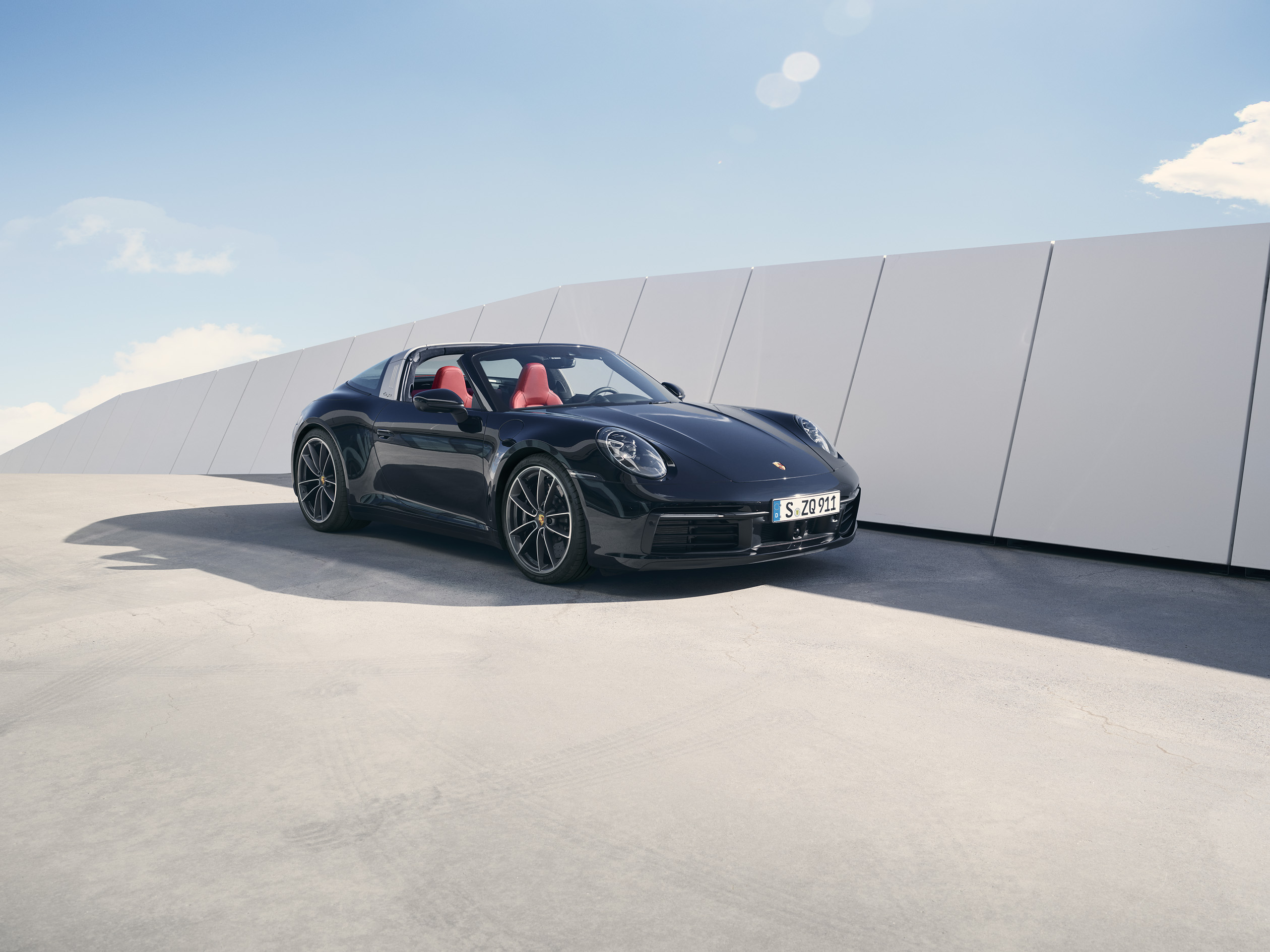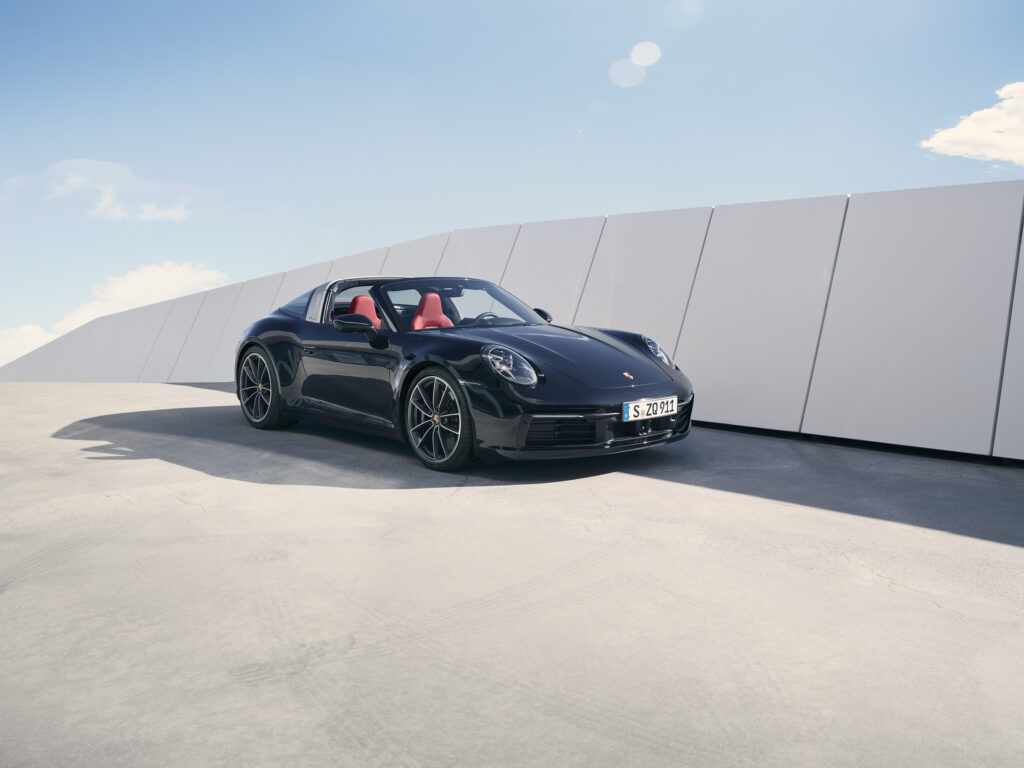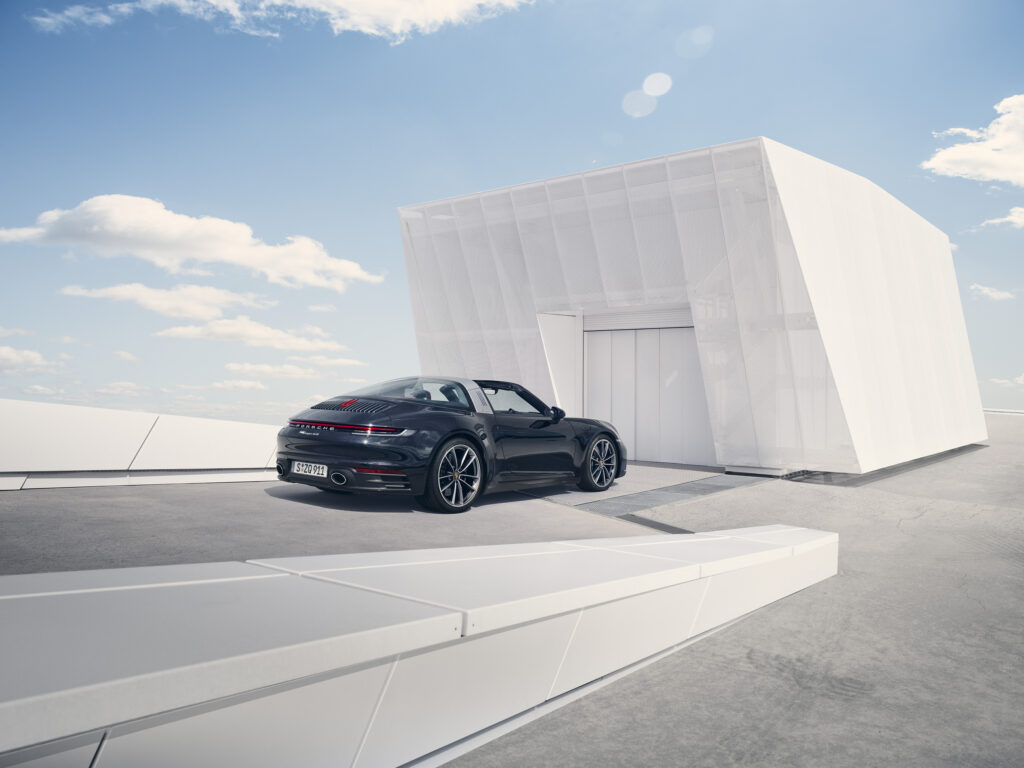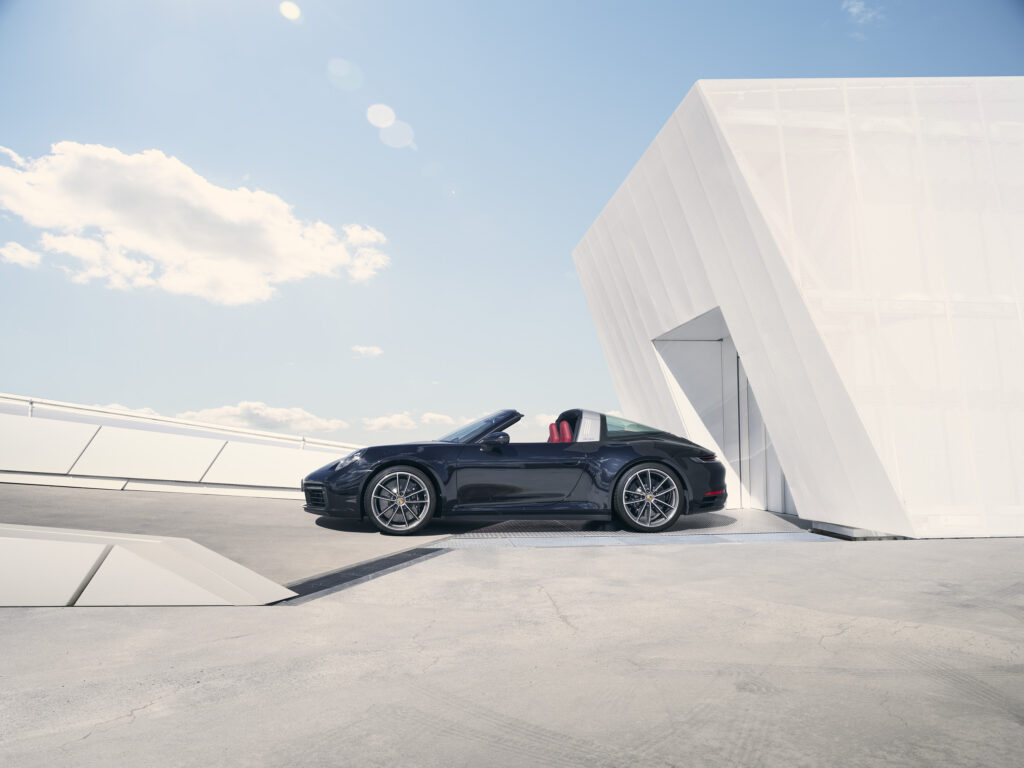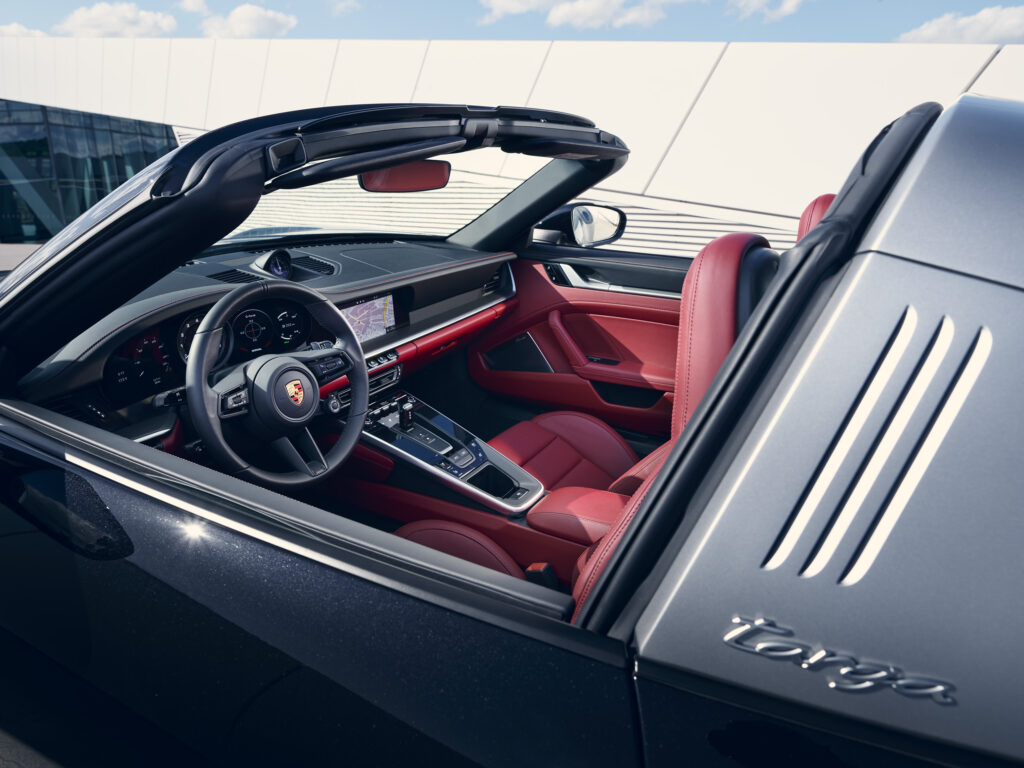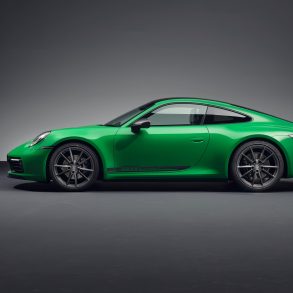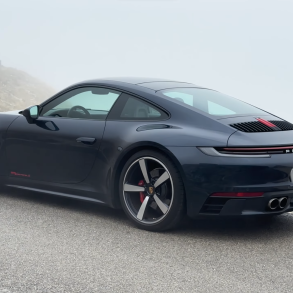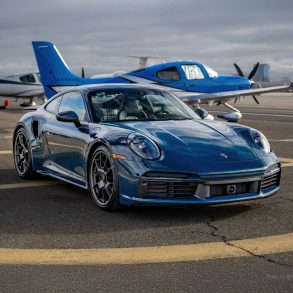2021 – 2024 Porsche 911 Targa 4S (992.1) – Reviews, Pricing, Specs & Buyers Guide
Among 992-generation 911s, the Targa 4S is the extrovert with depth. You get the classic brushed-metal hoop and wraparound glass, a fully automated, theater-caliber roof show, and the real-world pace of the S-spec twin-turbo flat-six. Crucially, you can choose ruthless PDK or a seven-speed manual (bundled with Sport Chrono) while keeping the sure-footed confidence of all-wheel drive (PTM). From its 2021 U.S. arrival through the end of the pre-facelift run in 2024, the 992.1 Targa 4S proved that “character” and “capability” don’t have to trade blows.
Porsche revealed the 992-series Targa 4 and 4S in May 2020, re-establishing the Targa as the third body style after coupe and cabriolet. The headline items were the 19-second automated roof ballet and the option to pair the 4S with a no-cost 7-speed manual (Sport Chrono included). Both Targa variants shipped with PDK and PTM all-wheel drive as standard; the 4S stepped up to the S-tune engine and (uniquely among Targas) could be ordered with the manual.
The Targa format remains faithful to the 1965 original—roll hoop + removable roof panel + huge glass dome—but the 992 transforms that heritage into push-button theater: press the switch and the rear glass clamshell lifts, the fabric panel folds, and everything tucks away in ~19 seconds. It’s the only 911 that makes “opening the roof” a ritual.
Powertrain, Driveline & Chassis
Engine (M9A family): 3.0-liter twin-turbo, direct-injected flat-six
Output: 443 hp @ 6,500 rpm; 390 lb-ft @ 2,300–5,000 rpm
Max engine speed: 7,500 rpm
Compression: 10.2:1
Transmissions:
-
8-speed PDK dual-clutch (standard)
-
7-speed manual (no-cost option on Targa 4S; includes Sport Chrono)
All-Wheel Drive: Porsche Traction Management (PTM) with an upgraded front-axle drive unit versus prior generations for accuracy under load; rear-biased feel in the dry.
Chassis & Hardware:
-
MacPherson-strut front / multi-link rear; PASM adaptive damping
-
Variable-ratio EPAS; with optional rear-axle steering the effective ratio quickens (≈14.1:1 on-center to 12.25:1 off-center) and turning circle tightens.
-
Brakes: 350/350 mm iron rotors with 6-piston/4-piston fixed calipers (red) on 4S; PCCB ceramics available.
-
Staggered wheels/tires: 20/21-in (8.5J x 20 front, 11.5J x 21 rear; 245/35 ZR20 & 305/30 ZR21).
Dimensions, Weight & Practicality (U.S. 2024 sheet, representative for 992.1):
Length 177.9 in | Width (w/o mirrors) 72.9 in | Height ~51.2 in | Wheelbase 96.5 in.
Curb weight: 3,687 lb (PDK); 3,602 lb (manual).
Fuel tank: 17.6 gal.
Cargo: 4.66 cu-ft frunk, plus 5.75 cu-ft behind the front seats with the backrests folded.
Performance: Claims vs. Reality
From the factory, the Targa 4S PDK is rated 0–60 mph in 3.6 s (Sport Chrono) and 188 mph flat out; the 7-speed manual carries the same top-speed claim with a slower official 0–60 due to launch mechanics.
Instrumented tests demonstrate the 992’s habit of over-delivering:
-
MotorTrend launched a 2021 Targa 4S PDK to 0–60 mph in 3.0 s and an 11.3-second quarter-mile @ 122.5 mph—super-car territory for a glass-roof 911 with a roll hoop.
-
Car and Driver’s first drive underscored that the Targa 4S’s extra kit (PASM, performance options) doesn’t blunt the core 992 magic; the car “didn’t disappoint,” though they noted how options can push the sticker into Turbo money.
The takeaway: on real roads the Targa 4S is as quick as you’ll ever need, and the AWD + PDK combo delivers those numbers repeatably, in all seasons.
The Roof (and Why It Matters)
A Targa lives or dies by its top. In 992 form, the mechanism is fast, precise, and refined: ~19 seconds from coupe-like to open-air (and back), with the massive rear glass lifting to swallow the fabric panel. It’s as much theater as convenience, and it’s a big part of why owners choose the Targa over the cabriolet: the hoop and rear dome shape the airflow, visibility and vibe in a way no other 911 can match.
Tech & Cabin
- PCM 6.0 (MY2022-on): Porsche’s January 2022 update brought a refreshed UI and Android Auto to compatible 911s (CarPlay was already supported). If smartphone integration matters, 2022+ cars are the target—or verify software level on an earlier example.
- Wet Mode (992 family): Acoustic sensors in the front wheel housings detect water spray and pre-condition stability/torque strategies; the cluster prompts you to engage a wet-optimized map. For a four-season Targa, it’s not a gimmick.
Ergonomically, the 992 cabin blends a wide, horizontal dash (a nod to early 911s) with a large center screen and mostly-digital gauges. The Targa’s huge glass gives the cockpit a light, airy feel even with the roof shut; with it open, buffeting is well controlled.
How It Drives
Calm, connected, and quick. The S-tune flat-six spools quickly for a fat mid-range; PDK anticipates inputs like it’s in your head; and PTM traction lets you deploy power early without corrupting the steering. The Targa’s structure is impressively stiff considering the packaging; roof-closed refinement is near-coupe, roof-open ambience is addictive. Reviewers agree on the vibe even when they nitpick the numbers. Car and Driver said the 2021 Targa “borders on spectacle,” called out the base 4 vs 4S power jump, and noted how options inflate the price—but the experience remains compelling. Top Gear cheekily labeled it “the least dynamic, most flawed 911—which still means it’s a beltingly good sports car,” a back-handed compliment that captures the truth: you give up a whisper of ultimate edge for a lot of charm.
Model-Year Updates
- 2021 (U.S. launch): Targa 4S arrives with 443 hp/390 lb-ft, PDK standard, AWD (PTM), 0–60 3.6 s (with Sport Chrono), 188 mph top speed, and the no-cost 7-speed manual option bundled with Sport Chrono. Roof cycle ~19 s.
- 2022: PCM 6.0 infotainment update adds Android Auto and UI tweaks to applicable cars; no core powertrain changes specific to the 4S.
- 2023–2024: Running refinements and package shuffles; the core Targa 4S recipe holds until the 992.2 refresh (MY2025+), outside this guide’s scope.
Specifications (Quick Reference)
- Engine: 3.0-L twin-turbo flat-six — 443 hp / 390 lb-ft
- Redline: 7,500 rpm
- Transmissions: 8-spd PDK; 7-spd manual (no-cost option)
- Drivetrain: AWD (PTM)
- Brakes (S): 350/350 mm iron, 6-piston front/4-piston rear; PCCB optional
- Wheels/Tires: 20″/21″ — 245/35 & 305/30
- 0–60 mph (factory): 3.6 s (PDK w/ Sport Chrono)
- Top speed: 188 mph
- Curb weight: 3,687 lb (PDK) | 3,602 lb (7-MT)
- Roof: ~19 s open/close
- Cargo: 4.66 cu-ft frunk; 5.75 cu-ft behind seats with backrests folded
- (Independent test: 0–60 in 3.0 s, 11.3 s @ 122.5 mph quarter-mile, MotorTrend.)
Options & Packages That Matter
- Sport Chrono Package. Brings the steering-wheel mode switch, Launch Control (PDK), dynamic engine mounts, and performance timers. It’s standard when you spec the 7-MT, and it unlocks the quickest official times on PDK cars.
- Rear-Axle Steering. Makes the car feel smaller in tight bends and steadier at speed; works brilliantly with the Targa’s relaxed-but-rapid mission. Ratio/turning-circle improvements are documented in the factory spec sheet.
- PASM vs. PASM Sport (-10 mm). Standard PASM is superb for mixed roads; the lower Sport tune suits smooth pavement or frequent canyon runs.
- PCCB (ceramics). Big fade resistance and unsprung-mass savings; fantastic for repeated hard stops, expensive to repair if damaged.
- Front-Axle Lift. A driveway and city-curb sanity saver.
- Targa details. The hoop can be ordered silver or black; roof fabric and color combos influence desirability and resale. (Launch materials show both executions.)
Reception & Reviews (Snapshot)
- MotorTrend First Test: “Sizzling” performance; 3.0-second 0–60 and 11.3-second quarter confirm the 4S is serious speed with glass-roof drama. Handling “nearly as good” as a Carrera 4S coupe.
- Car and Driver: “Borders on spectacle” and “beautiful to drive at any price,” with the caveat that heavy optioning pushes price into Turbo terrain.
- Top Gear (HDE context): “Least dynamic… yet a beltingly good sports car,” capturing the small trade of ultimate edge for uniqueness and ritual.
- Edmunds (992 family): “Expertly fills the middle ground between touring and scintillating performance,” an apt summary of the Targa’s mission.
Buying Guide (Used)
- Roof system health. Cycle the top several times. It should operate smoothly and in ~19 s with even latching and no chafing; check seals after a wash and confirm the rear glass lifts/lowers smoothly. The mechanism is robust but complex—perfect behavior is table stakes.
- Transmission choice. PDK delivers brutal, repeatable pace in any weather. The 7-MT (no-cost) trades a few tenths for engagement and includes Sport Chrono by default—valuable for both feel and resale.
- Tires, wheels & alignment. Standard Targa 4S runs 20/21-inch wheels with 245/35 and 305/30 tires; inspect inner shoulders on the rears and inner barrel lips for rash. Ask for alignment records—rear-steer and aggressive camber accelerate inner wear.
- Brakes. The 350 mm iron setup is excellent for road use; check for lip ridges and pedal pulsation. PCCB lasts a long time on the street but rotor damage is pricey—inspect faces closely.
- Infotainment & phone needs. If Android Auto matters, target MY2022+ or verify PCM 6.0 on the car you’re eyeing.
- Wet-weather systems. On a rainy test drive (or through spray), the cluster should suggest Wet Mode; no prompt (or warnings) warrants a scan.
- Provenance & options. Pull the build sheet/window sticker. Value-relevant boxes: Sport Chrono, rear-axle steering, PASM Sport, PCCB, front-axle lift, desirable color/hoop/roof combinations, and premium audio.
Ownership Experience & Verdict
Roof closed, the Targa 4S is quiet, refined, and relaxed in PASM Normal; roof open, buffeting is well controlled and visibility is superb thanks to the glass dome. The frunk + rear shelf (with backrests folded) make weekender packing easy. In foul weather, PTM traction and Wet Mode make it the 911 you’ll reach for more months of the year, which is the whole point of this body style. Running costs are sensible for the performance on tap: rear tires will go first, iron brakes last well, and fuel economy is in the same ballpark as other 992 S models.
The 992.1 911 Targa 4S is the romantic engineer’s 911: a car that makes every roof cycle feel like a little ceremony yet backs it up with S-grade pace and four-season composure. Spec Sport Chrono, decide between PDK efficiency or 7-MT engagement, consider rear-axle steering if you live on tight roads, verify PCM 6.0 if Android Auto matters, and make sure the roof is perfect. Do that, and you’ll own the 911 that feels special at 5 mph or 150, every single time.
What We Said At Launch
Upgrading from a Targa 4 to 4S isn’t cheap. While you can get into a base Targa for $122k, a Targa 4S starts at $138k, a $16k premium. So what do you get?
Like the standard 4S, the Targa 4S produces 443 bhp @ 6500 rpm from a six-cylinder, 3.0-litre boxer engine with twin turbochargers, and puts it to the road via an eight-speed PDK and Stuttgart’s refined all-wheel-drive system. 390 ft lbs from as low as 2300 rpm also means you have tons of mid-range power on tap for any situation. Compared to the previous generation Targa 4S, the new model is up 23 hp and 22 ft lbs of torque.
As with the other S variants, a seven-speed manual transmission is offered as a no-cost option. When you choose the manual, it replaces the electronically controlled limited-slip differential with a conventional limited-slip unit and includes the otherwise optional Sport Chrono package, which adds drive modes and dynamic engine mounts.
It benefits from 992-generation updates including a redesigned version of Porsche’s Active Suspension Management (PASM) dampers; a wider front track; staggered-size wheels featuring 245/35ZR tires on 20-inch wheels at the front and 305/30ZR tires on 21-inch rears; and a variable, electronically controlled locking rear differential. It doesn’t punish you over harsh pavement, especially in Comfort mode, and its steering feel and turn-in are simply divine in any day-to-day situation. In his testing, however, Walton gives a slight edge to the steering feel of the rear-drive 911s.
The Targa 4S is only 0.2 seconds slower to 60 mph than the Carrera 4S, accomplished in an impressive 3.4 seconds with launch control enabled. This is really impressive when you consider that a loaded Targa 4S weighs close to 4,000 lbs, which is meaningfully heavier than the Carrera 4S coupe. This is still a stupendously fast car.
And here is the thing. You don’t buy a Targa for outright pace or handling. This isn’t the sharpest 911 you can buy, but the numbers don’t tell the full story and the differences are miniscule. The Targa 4S is insanely fast and dynamically amazing compared to just about anything else on the road. A couple of years ago, these were supercar numbers and this kind of handling was unheard of at this price point. Now these numbers are just everyday performance from a 4S version of a modern-era 911. And you get the comfort of all-wheel drive, a nice interior, good tech and the sexiest bodystyle on the planet. Objectively, it is hard to complain too much.
Motortrend: The Targa 4S is also flat-out fast when you want it to be. Simply hold down the brake, rev its twin-turbo flat-six to 5,000 rpm or so, then let off the brake and drop the hammer. Our test team was able to launch Porsche’s latest 992-series 911 Targa variant to a sizzling 3.0-second-flat 0-60-mph sprint and on to an 11.3-second quarter mile at 122.5 mph.
The 911 coupes are stiffer than the convertibles, and the Targa feels a little more like the latter. The structure trembles a touch more over high-frequency washboard, and the tremors are amplified through the steering column. With the top peeled back and the wind deflector deployed from windscreen frame, there’s a bit of booming wind buffeting that occurs around 50 mph. It isn’t the end of the world, but if we were to ding the Targa 4S that is the worst thing we could say.
Videos & Reviews
Pictures
Press Release
May 17, 2020
Porsche debuts the 2021 911 Targa 4 and 4S models
The design icon enters its eighth generation with more power and updated features
Atlanta, Georgia. Following the Coupe and Cabriolet, the third body style of the new 911 generation is now making its debut with the all-wheel drive 911 Targa 4 and 911 Targa 4S models. The innovative, fully automatic roof system remains its distinguishing feature, and just like the legendary original Targa model from 1965, it features a characteristic Targa bar, a retractable roof section above the front seats and a wraparound rear window. The roof can be automatically opened and closed in just 19 seconds at the touch of a button.
Both models are fitted with an eight-speed dual-clutch transmission (PDK) and intelligent all-wheel drive Porsche Traction Management (PTM) as standard to deliver compelling performance, traction and driving pleasure. Alternatively, the 911 Targa 4S can be ordered with a seven-speed manual transmission at no charge, which includes the Sport Chrono package as standard.
Both 911 Targa models are powered by a six-cylinder, three-liter twin-turbo boxer engine: the 911 Targa 4 now delivers 379 hp and accelerates from zero to 60 mph in just 4.0 seconds when equipped with PDK and the optional Sport Chrono Package – one tenth quicker than the previous model. The engine in the 911 Targa 4S puts out 443 hp and reaches the 60 mph mark in just 3.4 seconds with PDK and the optional Sport Chrono Package – four tenths quicker than its predecessor. The top track speed of the new 911 Targa 4 is 179 mph, while the 4S peaks at 188 mph.
Like on the 911 Carrera models, Porsche InnoDrive, which includes adaptive cruise control, is optionally available on PDK-equipped models for the first time. And thanks to the enhanced Smartlift function for the optional front axle lift system, frequently visited locations can be programmed so that the front end of the car is raised automatically when needed. The thorough array of options is supplemented by an extensive range of accessories from Porsche Tequipment and new personalization options from Porsche Exclusive Manufaktur. Additionally, Porsche will expand the combination of traditional styling elements, timeless design and cutting-edge technology in a special edition of the 911 Targa, which will make its debut in June.
Powerful twin-turbo boxer engines
Like the 911 Carrera models, both 911 Targa variants profit from an increase in power compared to the previous generation of three-liter twin-turbo six-cylinder boxer engines. The engine in the 911 Targa 4 produces 379 hp at 6,500 rpm, which is nine hp more than its predecessor. Its maximum torque of 331 lb-ft is delivered across a wide engine speed range from 1,950 to 5,000 rpm. Making 443 hp, the 911 Targa 4S delivers 23 hp more than the previous model and generates 390 lb-ft of torque (22 more than before) between 2,300 and 5,000 rpm.
Optimized all-wheel drive for even better traction
The enhanced performance of the new all-wheel drive models goes hand-in-hand with further development of the front-axle drive system that was already introduced in the 2020 911 Carrera 4 and 4S Coupe and Cabriolet models. The clutch and differential unit is water-cooled and has reinforced clutch discs for greater strength and a higher load capacity. The increased actuating torque at the clutch improves its adjustment accuracy and the function of the front-axle drive. Overall, the enhanced front-axle drive with Porsche Traction Management (PTM) contributes to even better traction in all road conditions.
Further developed chassis for increased comfort and sharper handling
Like on all Porsche 911 Carrera models, the electronically-controlled variable damping Porsche Active Suspension Management (PASM) system is standard equipment on the new 911 Targa models. This system automatically adjusts the damping characteristics focused on maximizing driving comfort and handling to each driving situation, and has two modes that can be activated by the touch of a button: Normal and Sport. Porsche Torque Vectoring Plus (PTV Plus), which includes an electronic rear limited slip differential with fully variable torque distribution, is standard for the Targa 4S with PDK and is available as an option on the Targa 4. When ordered with the manual transmission, the 911 Targa 4S comes fitted with a mechanical rear limited slip differential. Like the other eighth generation Porsche 911 variants, the Targa models are also equipped with Porsche Wet Mode as standard. Sensors fitted in the front wheel housings are capable of detecting water on the road surface and, if significant volumes of water are picked up, the stability control system is automatically optimized for wet conditions, and a message in the instrument cluster provides a recommendation for the driver to manually switch to Wet Mode. Once the driver does so, the powertrain is then adapted to the conditions to help improve traction and stability in adverse weather conditions.
Like the 379 hp 911 Carrera models, the 911 Targa 4 comes standard with 235/40 ZR tires on 19-inch alloy wheels in front and 295/35 ZR tires on 20-inch wheels in the rear. The 4S model is fitted as standard with 245/35 ZR tires on 20-inch front wheels and 305/30 ZR tires on 21-inch rears – this larger wheel combination is optional for the 911 Targa 4. On the Targa 4, the standard cast iron rotors measure 330 millimeters in diameter front and rear and use black four-piston monobloc fixed calipers. The redpainted brake calipers on the Targa 4S have six pistons at the front axle, four at the rear, while its rotors measure 350 mm front and rear. The Porsche Ceramic Composite Brake (PCCB) can be ordered as an option for both models.
Extravagant Targa design with a modern interpretation
The most striking feature of the 911 Targa is of course its Targa bar and roof, which was adopted from the previous 991 generation model and optimized further. Harking back to classic Targa models of the 1960s and 1970s, the Targa bar comes standard in silver but can also be optionally ordered in black, and features the characteristic “Targa” model designation on each side, which has graced 911 Targa models since 1965. The roof construction consists of two flat magnesium elements, which hold the fabric roof in place securely and contribute to the elegant silhouette of the car. A heated glass rear window, sound-deadening material inside the fabric, as well as an extendable wind deflector integrated into the upper cowl frame of the windshield make the new 911 Targa comfortable and suitable for daily use.
The exterior of the 911 Targa is characterized by the design elements of its 992-model generation. Compared to its predecessors, its body features significantly more pronounced wheel housings at the front and, between its LED headlights, its front luggage compartment lid has a distinctive recess evoking the design of earlier 911 generations. The rear is characterized by a wider, variably extending rear spoiler and a seamlessly integrated and elegant light bar. With the exception of the front and rear fasciae, the entire outer skin is made from aluminum. The interior echoes the 911 Carrera models and is characterized by the clear and straight lines of its dashboard and its recessed instruments. The 911 models from the 1970s provided the inspiration here. Alongside the central tachometer – very much a defining feature for Porsche – two thin, frameless freeform displays offer key vehicle information for the driver. Five toggle switches providing direct access to important vehicle functions are located below the 10.9-inch center screen of the Porsche Communication Management (PCM). The standard PCM features include online navigation as well as Connect Plus (A subscription is required after an initial 12-month trial period).
The model for a new class of sports cars since 1965
The 1965 911 Targa 2.0 was a trailblazer for a completely new type of car. Originally marketed as a “safety cabriolet with supplemental roll bar”, the Targa, with its removable roof section, soon established itself as an independent concept and became a style icon. Right up to the present day, Porsche has continued to combine two worlds in the 911 Targa: the advantages of open-top driving in a cabriolet combined with the everyday comfort and interior feeling of a coupe.
Pricing and availability
The new 2021 911 Targa models are available to order now and are expected to reach U.S. dealers in late 2020. MSRP is $119,300 for the 2021 911 Targa 4 and $135,200 for the 2021 911 Targa 4S, not including a $1,350 delivery, processing and handling fee


